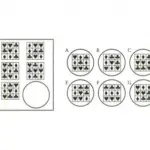
In intelligence assessment we can distinguish two types of evaluation: that of global intelligence and that based on the evaluation of multiple aptitudes (different skills that make up intelligence).
In this article We will learn about the Bennett, Seashore and Wesman Differential Aptitudes Test considered by many authors to be the first multiple aptitude battery in the history of psychological evaluation, designed in 1947.
Differential Aptitudes Test: characteristics
The Differential Aptitude Test (DAT) is a battery of differential aptitude tests (also called TAD), designed in 1947 by George K. Bennett, Harold G. Seashore and Alexander G. Wesman. It is one of the most widely used multi-capacity batteries and is considered by some authors to be the first to appear.
New revised and restandardized shapes were subsequently designed in 1962, giving rise to the L and M shapes, later the S and T shapes, and finally DAT 5, the latest version.
Initially, the Differential Aptitudes Test was designed for high school students. Currently it is frequently used for vocational and educational guidance processes.
Attitude could be defined as the ability to learn something. The Differential Aptitude Test (DAT) measures students’ ability to learn or act effectively in a certain number of areas, as well as to evaluate the potential of a job candidate for the successful development of their profession.
Technical data
The original name of the test is Differential Aptitudes Test. Your application can be individual or collective. The duration is 120 minutes for the 1st section and 1150 minutes for the 2nd section, and its scope of application is for ages 12 and up.
As for the material, it is made up of booklets, answer sheets, a pencil, scoring keys, and a stopwatch.
Applications
The Differential Aptitudes Test is used to measure the capacity that a person has in different areas of their abilities; That is why it is considered a “potency” test.
The skills and abilities it measures are those identified as the most important in multiple educational and vocational situations.
What does it evaluate?
The purpose of the Differential Aptitudes Test is to evaluate verbal, numerical, abstract, mechanical reasoning, spatial relationships, spelling, speed and perceptual accuracy.
Test Tests
The test It is made up of 7 tests that make up the test each of which is named after the aforementioned factors:
1. Verbal Reasoning (VR)
This test measures the person’s ability to understand concepts formulated in words, as well as the ability to abstract concepts or generalize and think constructively.
In this test, the tested subject must choose among 5 words, the one that best completes the analogy. For example: “… is to the right as west is to…”
2. Calculus (C)
Here it is evaluated understanding of numerical relationships and ease of handling numerical concepts. It offers a measure of the subject’s ability to reason with numbers, manage numerical relationships, and work with quantitative materials.
3. Abstract Reasoning (AR)
It aims to evaluate the non-verbal part of reasoning ability. In this test, the subject must discover What principles govern the transformation of the figure and demonstrate that understanding by designating the diagram that should logically follow the series.
4. Mechanical Reasoning (MR)
This test has illustrations where mechanical situations are shown, accompanied by a question asked in simple terms. The items are presented based on simple mechanisms frequently found in everyday life.
5. Spatial Relations (RE)
The subject’s ability to handle specific materials is measured through visualizations. The task is related to what certain objects would look like if they were arranged and rotated.
6. Spelling and Language (O and L)
In this case, these two tests are more performance tests than aptitude tests. The scores here are divided into two (one for each test), but are also considered together, as they provide an estimate of the person’s ability to distinguish between correct and incorrect use of language.
7. Speed or Perceptual Accuracy (VP)
These are intended to evaluate the subject’s response speed in a simple perceptual task. The subject examined here must look at the combinations marked in the test booklet, and then look for the same combination in a group of several similar ones, printed on the answer sheet.
Considerations in your application
When administering the Differential Aptitudes Test, three factors must be taken into account: adequate planning of the test, correct chronology and applying it in appropriate physical conditions for the subject and the examiner.
On the other hand, the test can be administered in whole or in part. Thus, the analysis of the scores can be carried out for each test separately or integrating the information that results from the application of several or all of the subtests.








